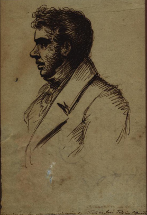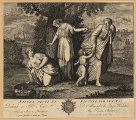U.Porto Memory
University of Porto Famous Alumni
José Teixeira Barreto
 |
José Teixeira Barreto 1763-1810 Painter and collector |
José Teixeira Barreto was the son of Domingos Teixeira Barreto, a painter, gilder and gilt work carver who lived and worked in Santo Ildefonso, and of Josefa Maria Angelica. He was born in Porto on 19 March 1763 and was baptised six days later in the church of Santo Ildefonso.
 He began his apprenticeship as a painter in his father’s workshop and attended the school "Porta do Olival" and the Sketching and Drawing Class.
He began his apprenticeship as a painter in his father’s workshop and attended the school "Porta do Olival" and the Sketching and Drawing Class.
On 21 November 1782 he received the Benedictine habit at the Monastery of S. Martinho de Tibães, in the district of Braga and adopted the name of Friar José da Apresentação. In this early phase of his life he painted several works for the monasteries of Tibães and Santo Tirso. When he went to Lisbon to study Drawing with professor Joaquim Manuel da Rocha, he lived in the Monastery of S. Bento da Saúde (which today houses the Assembly of the Republic).
In 1790, five years after moving to Lisbon, he travelled to Rome along with Francisco Vieira, to improve his painting skills, visit the Italian art museums and copy Classical art pieces. While in Italy, he studied with masters Marcelo Lombardi, José Cades and Cagnereaux and left the religious order through the intervention of ambassador D. Alexandre de Sousa de Calhariz e Holstein, his protector, who granted him a monthly allowance.
 At that time, he produced several works, such as two etchings in 1794 and 1795, dedicated to his patron, and 41 prints for the book "Scherzi Poetici Pittorici" by Giovanni Gherardo Rosse, published in the deluxe edition of that work (Parma, 1811), offered to Napoleon.
At that time, he produced several works, such as two etchings in 1794 and 1795, dedicated to his patron, and 41 prints for the book "Scherzi Poetici Pittorici" by Giovanni Gherardo Rosse, published in the deluxe edition of that work (Parma, 1811), offered to Napoleon.
When he returned to Portugal, he brought a vast collection of paintings, which later became part of the museum in the Monastery of Tibães (scattered after 1834, it eventually became part of the Porto Museum), the relics of the virgin and martyr Saint Claire, kept in the Church of Terço (1798) and then transferred in 1803 to the Chapel of Bonfim, and three books with drawings, two of which now belong to the Faculty of Fine Arts of the University of Porto and the other to the National Museum Soares dos Reis.
 In the post-Roman period, he authored the paintings of the upper choir of the Church of de Santo Tirso, the dressing-room curtains of the upper choir of Church of Venerável Ordem Terceira de S. Francisco, in Porto (c. 1800), the upper choir curtains of the parish Church of S. João da Foz, in Porto, paintings for the monasteries of S. João de Pendorada and Santa Maria de Pombeiro, possibly two canvases for the Porto Church of S. Lourenço, now preserved in the National Museum Soares dos Reis ("S. Pedro mostrando a Eucaristia" and "O Maná"), a self-portrait (National Museum Soares dos Reis) and a portrait of painter Francisco Vieira, the “Portuense”.
In the post-Roman period, he authored the paintings of the upper choir of the Church of de Santo Tirso, the dressing-room curtains of the upper choir of Church of Venerável Ordem Terceira de S. Francisco, in Porto (c. 1800), the upper choir curtains of the parish Church of S. João da Foz, in Porto, paintings for the monasteries of S. João de Pendorada and Santa Maria de Pombeiro, possibly two canvases for the Porto Church of S. Lourenço, now preserved in the National Museum Soares dos Reis ("S. Pedro mostrando a Eucaristia" and "O Maná"), a self-portrait (National Museum Soares dos Reis) and a portrait of painter Francisco Vieira, the “Portuense”.
Between 1803 and 1810, he taught Drawing at the Royal Academy of Navy and Trade Affairs of Porto. He was appointed permanent teacher by royal charter of 1 October, earning 600 réis a year. In the final phase of his life, he asked to re-join the Benedictine Order, but died on 6 November 1810. He was buried the following day in a shallow grave bearing no. 18, in the transept of the Church of the Monastery of S. Bento da Vitória, in Porto.
José Teixeira Barreto left a vast legacy formed by his pictorial work and the paintings he collected. His own paintings became the property of the Benedictine Order. He was a most influential person in the painting field of his time. He created, the first painting museum in Portugal.
(Universidade Digital / Gestão de Informação, 2012)
Last updated: 2016-07-15 Webpage created on: 2025-06-14 03:14:12 Complaint Portal